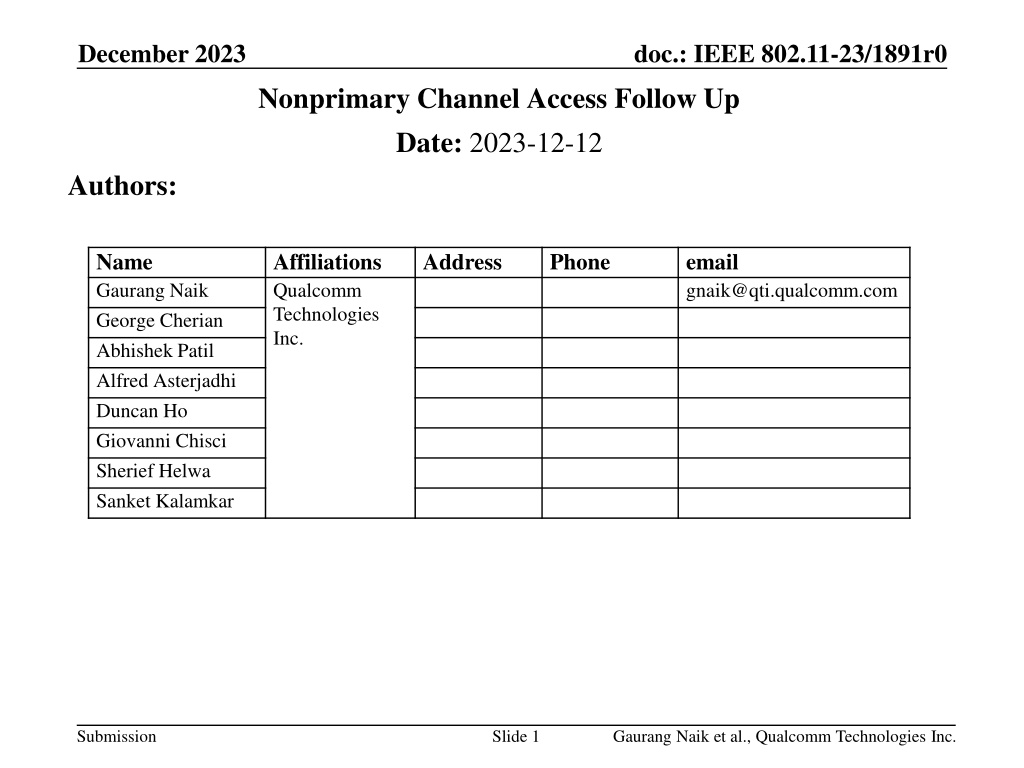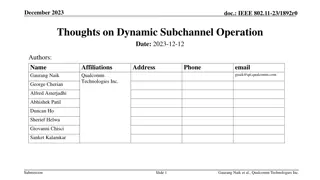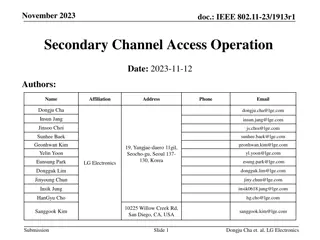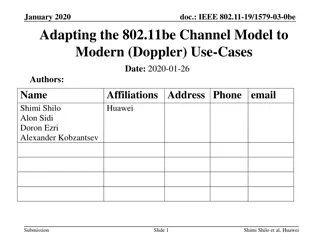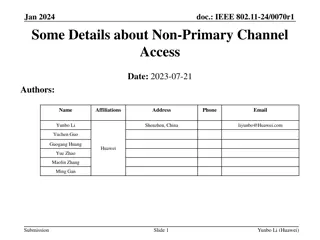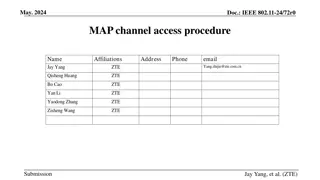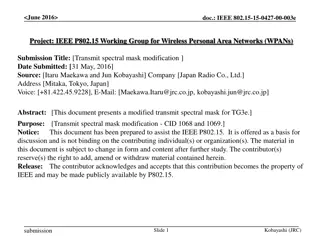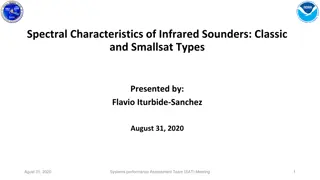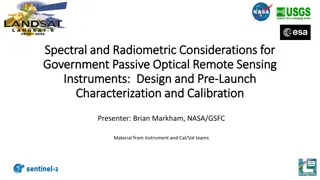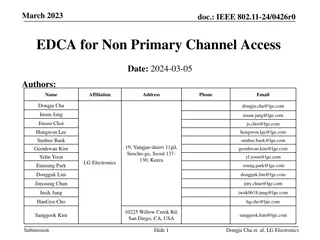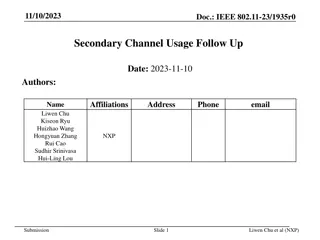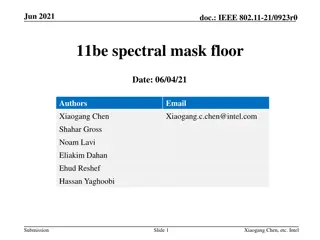Enhancing Spectral Efficiency Through Nonprimary Channel Access in IEEE 802.11
IEEE 802.11 is exploring nonprimary channel access to address underutilization of spectrum and improve latency and throughput. This approach involves enabling nonprimary channel access with simple modifications to existing rules, such as limiting TXOP duration and using control frames for coordination between devices. The nonprimary channel access protocol includes a process where APs and STAs switch between primary and nonprimary channels during OBSS detection. This innovative strategy aims to enhance spectral efficiency by leveraging unused spectrum resources effectively.
Download Presentation

Please find below an Image/Link to download the presentation.
The content on the website is provided AS IS for your information and personal use only. It may not be sold, licensed, or shared on other websites without obtaining consent from the author. Download presentation by click this link. If you encounter any issues during the download, it is possible that the publisher has removed the file from their server.
E N D
Presentation Transcript
December 2023 doc.: IEEE 802.11-23/1891r0 Nonprimary Channel Access Follow Up Date: 2023-12-12 Authors: Name Gaurang Naik George Cherian Abhishek Patil Alfred Asterjadhi Duncan Ho Giovanni Chisci Sherief Helwa Sanket Kalamkar Affiliations Qualcomm Technologies Inc. Address Phone email gnaik@qti.qualcomm.com Submission Slide 1 Gaurang Naik et al., Qualcomm Technologies Inc.
December 2023 doc.: IEEE 802.11-23/1891r0 Introduction IEEE 802.11 offers support for very large bandwidths EHT has defined support for up to 320 MHz However, access to wideband channels in 802.11 is contingent on access to the primary 20 MHz channel This limitation leads to underutilization of the spectrum Frequency S80 Unutilized resource Pre-UHR In-BSS Transmission S40 S20 OBSS Transmission P20 Time subchannels Harvesting this unutilized medium (BW) can help improve latency and throughput Nonprimary channel access can help improve the spectral efficiency Submission Slide 2 Gaurang Naik et al., Qualcomm Technologies Inc.
December 2023 doc.: IEEE 802.11-23/1891r0 Design Principles Enable nonprimary channel access with simple changes to the baseline 802.11 channel access rules These include Enable the feature without requiring concurrent packet detection/CCA capabilities on different subchannels Allow access only on one nonprimary channel To reduce coordination loss between AP & STA due to asymmetric view of the primary channel Limit the TXOP on nonprimary channel to the duration of OBSS TXOP on primary channel To ensure backward compatibility with legacy STAs Initiate TXOPs on nonprimary channel with a short Control frame To confirm the peer STA s presence on the nonprimary channel Submission Slide 3 Gaurang Naik et al., Qualcomm Technologies Inc.
December 2023 doc.: IEEE 802.11-23/1891r0 Nonprimary channel access protocol (1/2) When an OBSS PPDU is detected, AP & STAs switch to nonprimary channel and contend for access A TXOP on nonprimary channel is initiated with a Control frame AP & STAs return to the primary channel by the end of OBSS TXOP An illustration of downlink frame exchange using nonprimary channel access Control frame, addressed to STA Contend for access A C K Data (STA) R C Return to Primary R C Detect OBSS & Switch to Nonprimary Nonprimary AP OBSS Primary A C K C R Data (STA) C R Detect OBSS & Switch to Nonprimary Non-AP STA Nonprimary OBSS Primary Submission Slide 4 Gaurang Naik et al., Qualcomm Technologies Inc.
December 2023 doc.: IEEE 802.11-23/1891r0 Nonprimary channel access protocol (2/2) Device requirements A STA must be capable of switching dynamically from primary channel to nonprimary channel and vice versa Signaling considerations AP signals the nonprimary channel where contention is allowed AP and STAs signal their respective delays to switch from primary channel to nonprimary channel, and vice versa Medium synchronization Before initiating a TXOP on the nonprimary channel, a STA must follow baseline medium synchronization recovery rules Submission Slide 5 Gaurang Naik et al., Qualcomm Technologies Inc.
December 2023 doc.: IEEE 802.11-23/1891r0 Gain Analysis Setup 1: Idealistic Scenario (above ED) Theoretical gains Assumptions: Two BSSs are in ED range Primary channels are the same No adjacent channel interference Concurrent CCA/PD on subchannels Notations: In-BSS occupancy fraction = p BW ratio = In-BSS BW / OBSS BW Submission Slide 6 Gaurang Naik et al., Qualcomm Technologies Inc.
December 2023 doc.: IEEE 802.11-23/1891r0 Setup 1 Idealistic Scenario (above ED) Topology All devices are within ED range, i.e., above -62 dBm Legacy BSS supports 40 MHz UHR BSS supports 80 MHz Total number of STAs = 10. Number of STAs in the UHR BSS is varied from 1 to 9. Remaining STAs are in the legacy BSS Define P = Fraction of STAs in the UHR BSS Traffic UL only, full buffer KPI Average Throughput gain of UHR STAs Channel and bandwidth configuration 1 10 Legacy AP UHR AP 5 9 2 AP 0 AP 1 8 4 6 3 7 Topology when P = 0.5 1 2 8 Legacy primary 9 3 AP 0 AP 1 (I) 7 UHR primary UHR channel BW 4 6 No nonprimary channel access (Baseline) 10 5 Legacy primary UHR Nonprimary UHR Primary (II) Topology when P = 0.2 UHR channel BW Nonprimary channel access enabled Submission Slide 7 Gaurang Naik et al., Qualcomm Technologies Inc.
December 2023 doc.: IEEE 802.11-23/1891r0 Setup 1 Simulation Results When all STAs are within ED range, the gain from nonprimary channel access matches the theoretical gains When the share of UHR and legacy contenders is 1:1, avg. throughput gain = 50%. Submission Slide 8 Gaurang Naik et al., Qualcomm Technologies Inc.
December 2023 doc.: IEEE 802.11-23/1891r0 Caveats When devices are assumed to be in ED range, gains of nonprimary channel access are promising However, the gains diminish if Primary channels of overlapping BSSs are different Overlapping BSSs are in the [PD, ED] range Transmitter and receiver have different views of the channel Medium sync recovery incurs delays Adjacent channel interference is non-negligible We discuss the performance gains in a more realistic setup in the next few slides Submission Slide 9 Gaurang Naik et al., Qualcomm Technologies Inc.
December 2023 doc.: IEEE 802.11-23/1891r0 Setup 2 Between PD and ED Topology with 4 APs, one associated STA each AP0 and AP1 are legacy APs (40 MHz) AP2 and AP3 are UHR APs (80 MHz) All APs hear each other b/w PD and ED threshold, i.e., b/w -82 to -62 dBm Traffic DL only, ON-OFF, all APs have same offered load KPI Average Throughput gain of UHR APs Legacy STA (random) 0 2 Legacy AP UHR AP UHR STA (random) 0 2 Legacy AP UHR AP 1 3 1 3 Channel and bandwidth configurations Legacy primary (B) Legacy primary Legacy primary UHR Primary (A) UHR primary UHR Nonprimary UHR Primary (C) UHR channel BW UHR channel BW UHR channel BW Nonprimary channel access enabled No nonprimary channel access (Baseline) Staggered primary channels Submission Slide 10 Gaurang Naik et al., Qualcomm Technologies Inc.
December 2023 doc.: IEEE 802.11-23/1891r0 Setup 2 Simulation Results Compared to baseline configuration (i.e., A) nonprimary channel access (i.e., C) provides modest gains in average throughput for UHR APs Gains are limited between 1.4 9.7% depending on offered load conditions However, staggering the primary channels of UHR and legacy APs (i.e., B) provides equivalent or more gains for UHR APs Gains are between 1 12.2% depending on offered load conditions Submission Slide 11 Gaurang Naik et al., Qualcomm Technologies Inc.
December 2023 doc.: IEEE 802.11-23/1891r0 Conclusions In these slides, we presented our views on various aspects of nonprimary channel access Gains of nonprimary channel access are scenario-specific Lower gains in the simulated scenario can be attributed to the increased spatial reuse for the baseline performance when APs are between the PD and ED threshold range In general, the gains are not as much as the idealistic theoretical estimates Furthermore, in the simulated scenario, gains from nonprimary channel access are smaller than or are comparable to the gains from staggering the primary channels of overlapping BSSs Nonprimary channel access protocol design must be simple with the following considerations: Enable the feature without the need for concurrent packet detection/CCA capabilities Allow channel access only on one nonprimary channel Limit TXOP on nonprimary channel to the OBSS TXOP on primary channel Initiate TXOP on nonprimary channel with a short Control frame Submission Slide 12 Gaurang Naik et al., Qualcomm Technologies Inc.
December 2023 doc.: IEEE 802.11-23/1891r0 SP Do you agree that TGbn will define a Nonprimary Channel Access (NPCA) mode that enables a STA to access the secondary channel (referred to as NPCA primary channel) when the primary channel is busy due to OBSS traffic? NPCA shall not assume that the STA is capable of detecting or decoding a frame and obtaining the NAV on the NPCA primary channel concurrently with the primary channel. A BSS shall only have a single NPCA primary channel on which the STA contends while the primary channel of the BSS is busy. Submission Slide 13 Gaurang Naik et al., Qualcomm Technologies Inc.
